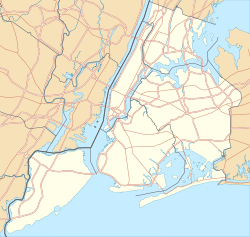The Evergreens Cemetery | |
 Southern (Bushwick Avenue) entrance | |
| Location | 1629 Bushwick Ave., Brooklyn, New York |
|---|---|
| Coordinates | 40°41′2.0″N73°54′4.3″W / 40.683889°N 73.901194°W |
| Area | 225 acres (91 ha) |
| Built | 1849 |
| Architect | Vaux, Calvert; etc |
| NRHP reference No. | 07001192 [1] |
| Added to NRHP | November 15, 2007 |
The Cemetery of the Evergreens, also called The Evergreens Cemetery, is a non-denominational rural cemetery [2] along the Cemetery Belt in Brooklyn and Queens, New York City. It was incorporated in 1849, not long after the passage of New York's Rural Cemetery Act spurred development of cemeteries outside Manhattan. For a time, it was the busiest cemetery in New York City; in 1929 there were 4,673 interments. Today, the Evergreens is the final resting place of more than 526,000 people. [3]
Contents
- History
- Notable burials
- Individual graves
- Group monument
- See also
- References
- Further reading
- External links
The cemetery borders Brooklyn and Queens and covers 225 acres (0.91 km2) of rolling hills and gently sloping meadows. It features several thousand trees and flowering shrubs in a park-like setting. Cypress Hills Cemetery lies to its northeast.




